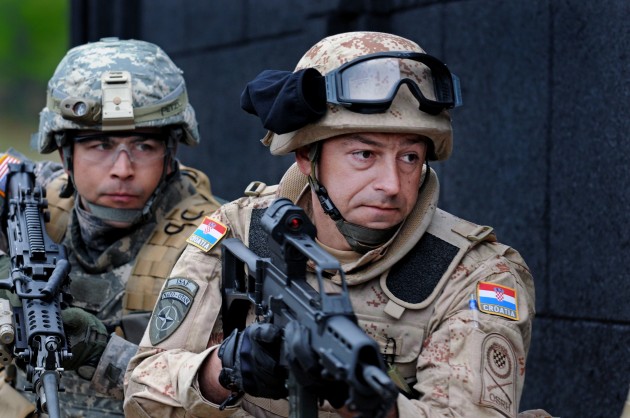
A Croatian soldier and a Minnesota National Guardsman train together for Afghanistan.
Yesterday, four mid-grade military officers — one from each armed service — made a remarkable public recommendation to their boss, Secretary of Defense Chuck Hagel: It’s time to force the four services back into clearly demarcated “lanes” and reduce overlap between them as budgets shrink and competition escalates. They focused on three high-priority areas:
- Cybersecurity, the one area of the budget that’s actually growing. As a result, all four services are training “cyber warriors” and creating “cyber” units — but with no clear guidance from the Defense Department on which service should specialize in what, so everyone is doing a bit of everything. “The services risk building similar capabilities in different ways to conduct the same mission,” the co-authors write, “[with] significant duplication and overlap.” Their (tentative) solution: take away some of the services’ authority to “train, equip, and organize” cybersecurity personnel and give it to the interservice Cyber Command. That step would raise CYBERCOM to a status currently enjoyed only by Special Operations Command (SOCOM), halfway to being a full-scale independent service.
- Drones, aka “unmanned aircraft systems” (UAS). “Currently,” they write, “the four services are developing 15 separate UAS platforms of varying weights, speeds and altitudes” (see exhibits 1, 2, 3, and 4), as well as “42 separate UAS payload development programs… [and] 13 ground control stations.” While they stop short of a specific recommendation here, the co-authors do note regretfully that the current UAS Task Force lacks “authority over the services for programmatic consolidation or termination.” (Hint, hint?) They also speak approvingly of the much-derided 1947 Key West agreement, which among other things defined what kind of (manned) aircraft each service could fly.
- So-called Phase Zero Operations, in which US troops train foreign forces, conduct exercises with them, and even quietly help them secure their countries. Historically, Special Operations Forces did the small-scale, low-profile, long-term work in the shadows, while the four services occasionally showed up for big high-profile exercises. But after 9/11, the “Big Army” and Marine Corps both had to build up Afghan and Iraqi forces, expertise they don’t want to lose. Now now they are to some extent competing (my word, not the authors’) with each other and with SOCOM for Phase 0 business around the world, especially in the high-profile Pacific. “The Department of Defense needs to provide the services guidance on their primary mission responsibilities in Phase 0 operations,” the four officer write, “instead of letting the services make their own decision about the force size and mix required.”
And those are just the top three: All told, the study identifies 10 areas of “excessive redundancy,” from nuclear deterrence to Apocalpyse Now-style riverine combat boats to chaplains. After 12 years of flush budgets and urgent wartime needs, the services have all built up “excessive duplicative capabilities [that] the Department of Defense can no longer afford,” write Navy Commander Clay Beers, Marine Lt. Col. Gordon Miller, Army Col. Robert Taradash and Air Force Lt. Col. Parker Wright. It’s remarkable to see a single document with co-authors from all four services, especially since these are not high-ranking guys.
The authors are all smack in the middle of the officer corps: Three of them are grade “O-5” and one is “O-6” on a scale from fresh-faced new lieutenant (O-1) to four-star general (0-10). (Taradash is the lone O-6). The four officers are all currently military fellows at the Center for a New American Security, an influential think tank with very close ties to the Obama White House. The officers emphasize they are speaking only for themselves, not for their services. They’re being so cautious, in fact, that there are no quotations from any of them in this article — and that’s not because I didn’t try.
Nevertheless, even wrapping their criticisms in anodyne language, they’re sticking their necks out a bit. Here’s hoping that their respective services reward their initiative rather than punish it.
Sullivan: Defense industry ‘still underestimating’ global need for munitions
National Security Advisor Jake Sullivan said that there are “no plans” for another Ukraine supplemental at this point.


























